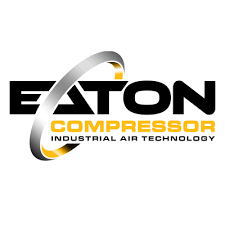Automotive Lift Service, Air Compressors and Tire Machines
Call Us Now!
(855) 919-5438 - (Lift) | (919) 275-9811
Automotive Lift Service, Air Compressors and Tire Machines
Call Us Now!
Compressed
Air Systems
Eaton Air Compressor Distributer and Installer in North Carolina
At L&D Shop Solutions since 1977, Eaton Compressor has been a leader in Rotary Screw Air Compressors. Made in the USA, their Rotary Screw Air Compressors are backed by the best warranty in the industry. It’s easy to put your money where your mouth is when your product is designed to last, using quality components and superior construction. Eaton products are of the highest quality and our choice for compressed air system products.

Buying Process for Our Compressed Air Systems
Our commitment to exceptional service extends beyond delivering high-quality compressed air systems. We offer a comprehensive service process to ensure the optimal performance and longevity of your system:
- System Assessment and Analysis: Our experienced technicians conduct a thorough assessment of your existing system or project requirements. We analyze factors such as air quality needs, flow rate, and pressure demands to develop customized solutions.
- Customized System Design and Installation: Based on our assessment, we design and install a compressed air system tailored to your unique specifications. Our team ensures proper sizing, component selection, and efficient layout for seamless integration into your operations.
- 24/7 Emergency Services: We understand that downtime can have significant consequences for your business. That's why we provide 24/7 emergency services to promptly address any unexpected issues and minimize disruptions to your operations.
- Compressed Air Quality Testing and Monitoring: To ensure compliance with industry standards and maintain optimal performance, we offer comprehensive air quality testing and monitoring services. Our team conducts regular tests to assess air quality and provides recommendations for improvement if needed.
Product Specifications for our Compressed Air Systems
All-in-One Compressed Air Systems
These integrated systems combine compressors, dryers, filters, and storage solutions in a single package. They are designed for easy installation, efficient operation, and optimal performance.
Compressed Air Monitoring Systems
Our advanced monitoring systems enable real-time tracking and analysis of compressed air parameters. You can monitor system performance, detect anomalies, and make informed decisions to optimize efficiency.
Compressed Air Distribution Systems
Our distribution systems ensure the proper delivery of compressed air to various points of use in your facility. They minimize pressure drops, optimize performance, and enhance productivity across your operations.
Compressed Air Piping System Loop Designs
Our expert team designs and installs compressed air piping systems with loop designs. This ensures balanced air distribution, minimizes pressure fluctuations, and maximizes efficiency throughout your facility.
Garage Compressed Air Systems
We offer specialized compressed air solutions designed specifically for garages and automotive applications. Our garage compressed air systems are tailored to meet the unique requirements of automotive workshops and body shops.
Frequently Asked Questions
-
What are Compressed Air Systems?
Compressed air systems are integral to various industries, providing a reliable and versatile source of power for a wide range of applications. A compressed air system consists of several components working together to generate, store, and distribute compressed air. These systems utilize mechanical energy to compress air, resulting in a high-pressure stream that can be harnessed for various industrial processes.
At L&D Shop Solutions, we offer a comprehensive range of high-quality compressed air systems. Our commitment to delivering reliable and efficient solutions makes us a trusted provider in the industry. Whether you need all-in-one compressed air systems, compressed air monitoring systems, compressed air distribution systems, compressed air piping system loop designs, or garage compressed air systems, we have the expertise to meet your specific requirements
-
Why are they important in various industries?
Compressed air systems are vital in numerous industries due to their clean and efficient power source for diverse applications. They provide flexibility, powering pneumatic tools and machinery, while ensuring reliability and consistent performance. Industries relying on uninterrupted operation, like manufacturing, automotive, and pharmaceuticals, greatly benefit from their steady stream of compressed air. Moreover, compressed air systems offer inherent safety advantages as non-conductive sources, minimizing electrical hazards in environments with sparks or flammable materials.
-
How do they work and what are the components involved?
Compressed air systems function through a series of stages that involve compressing, storing, and distributing air. The primary components of a typical compressed air system include:
- Compressor: The heart of the system, responsible for efficiently compressing ambient air to a higher pressure using technologies like rotary screw, reciprocating, or centrifugal.
- Air Treatment Equipment: Includes filters to remove contaminants, dryers to reduce moisture content, and separators to eliminate oil and impurities, ensuring the quality and suitability of compressed air for specific applications.
- Air Storage Tanks: Store compressed air as a reserve, acting as buffers to provide a consistent supply during peak demand periods and effectively manage fluctuations in air usage.
- Distribution System: Consists of pipes, valves, and fittings that transport compressed air from the storage tanks to various points of use throughout the facility, ensuring proper airflow and pressure for the efficient operation of pneumatic tools, machinery, and equipment.
- Controls and Safety Devices: Incorporate pressure switches, relief valves, pressure regulators, and other control components to monitor and regulate system operation, maintaining optimal performance and protecting against potential overpressure situations.
-
What is the lifespan of a compressed air system?
The lifespan of a compressed air system can vary depending on several factors, such as the quality of maintenance, usage patterns, and environmental conditions. With proper maintenance and regular servicing, a well-designed and installed compressed air system can last for many years.
-
What are the safety precautions when working with compressed air systems?
When working with compressed air systems, it is essential to follow safety precautions. These include wearing appropriate personal protective equipment (PPE), avoiding direct contact with compressed air streams, ensuring proper ventilation in enclosed spaces, and regularly inspecting and maintaining system components.
-
What are the signs of a malfunctioning compressed air system?
Signs of a malfunctioning compressed air system can include decreased airflow, excessive noise or vibration, fluctuating pressure levels, increased energy consumption, frequent air leaks, and poor equipment performance. If you notice any of these signs, it is advisable to have your system inspected promptly.
Request for Consultation
Looking for expert advice on choosing the right compressed air system? Request a consultation with us today! Our experienced team is here to assess your needs, answer your questions, and provide tailored recommendations. Contact us at
(919) 275-9811 or
(855) 919-5438 to schedule your consultation and discover how our compressed air solutions can optimize your operations.
188 Medical Dr, Angier, NC 27501, United States of America
